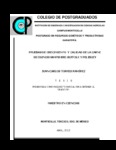Pruebas de crecimiento y calidad de la carne de ovinos Hampshire-Suffolk y Pelibuey
Abstract
Se realizó un estudio para evaluar el efecto de dietas sorgo y maíz-soya en la ganancia diaria de peso (GDP), consumo de alimento (CON), conversión alimenticia (CA), espesor de la grasa dorsal del músculo del lomo (EGAML) y área del músculo del lomo (AML) en corderos Hampshire x Suffolk (HS) y Pelibuey (PB). Los corderos fueron alojados en corraletas individuales y alimentados ad libitum. EGAML y AML fueron medidos entre la 12a and 13a costilla con ultrasonido. Los corderos fueron asignados aleatoriamente a las dietas en un diseño completamente al azar. El peso inicial de los corderos (n=30) varió de 26 a 27 kg con 3 y 4 meses de edad, respectivamente par HS y PB. La duración de la prueba fue de 75 d; los primeros 15 días fueron de adaptación a la dieta. Al término del periodo de engorda (60 d), se sacrificaron cuatro corderos de cada dieta y se evaluó el peso de la canal caliente (PCC) y fría (PCF), rendimiento en canal (RC), pH, textura (TEX) y color de la carne. Los corderos HS alimentados con dietas maíz- soya (T2 y T3) tuvieron mejores PF y AML (P<0.05) que aquellos alimentados con sorgo-soya. No hubo diferencias (P>0.05) en las demás variables evaluadas, cuyos promedios fueron: PF, 47.4±1.1 y 38.8±0.65 kg; GDP, 0.372±0.01 y 0.224±0.09 g; CA, 4.6±0.18 y 6.27±0.38, respectivamente. Así mismo, los valores de AOC y EGD fueron de 10.87±0.10 y 9.86±0.26 cm2; 3.80±0.10 y 2.80±0.10 mm, para corderos HS y PB, respectivamente. Se observaron diferencias (P<0.05) en PCC, PCF y RCC, siendo mejor la dieta maíz-soya (T2) en corderos H x S, lo cual no ocurrió en PB (P>0.05). No se observaron diferencias entre tratamientos (P>0.05) en pH y color de la carne, presentando valores similares entre genotipos. Se concluye que los tratamientos maíz-soya evaluados (T2 y T3) tuvieron una tendencia (P<0.10) a presentar promedios más altos en las variables de comportamiento analizadas, no observando diferencias, dentro de genotipo, en las características de la carne. _______________ EFFECT OF DIET ON GROWTH PERFORMANCE AND MEAT CHARACTERISTICS PELIBUEY AND HAMPSHIRE SHEEP- SUFFOLK. ABSTRACT: A study was conducted to evaluate the effect of dietary sorghum and corn-soy in daily gain (ADG), feed intake (CON), feed conversion (FC), backfat thickness of loin muscle (LMFT) and loin muscle area (LMA) in Hampshire x Suffolk lambs (HS) and sheep (PB) .The lambs were housed in individual pens and fed ad libitum. LMFT and AML were measured between the 12th and 13th rib with ultrasound. The lambs were randomly assigned to diets in a completely randomized design. The initial weight of lambs (n = 30) ranged from 26 to 27 kg with 3 and 4 months of age, respectively couple HS and PB. The test duration was 75 d, the first 15 days were adaptation to the diet. At the end of the fattening period (60 d), from each diet were slaughtered and assessed the hot carcass weight (PCC) and cold (PCF), carcass yield (RC), pH, texture (TEX) and meat color. HS lambs fed corn-soybean diets (T2 and T3) had better PF and AML (P <0.05) than those fed sorghum-soybean. There were no differences (P> 0.05) in the other variables assessed, whose averages were: PF 47.4±1.1 and 38.8±0.65 kg; GDP, 0.372±0.01 and 0.224±0.09 g; CA, 4.6±0.18 and 6.27±0.38, respectively. Likewise, the values of AOC and EGD were of 10.87±0.10 and 9.86±0.26 cm²; 3.80±0.10 and 2.80±0.10 mm, in HS and PB, respectively. Differences were observed (P <0.05) in PCC, PCF and RCC, being better the diet corn-soya (T2) in lambs H x S, lo which didn't happen in PB (P>0.05); pH and meat color were not different among treatments (P>0.05), with similar values among genotypes. The corn-soybean treatment (T2 and T3) showed higher averages (P<0.10) on productive performance, with similar values in the characteristics of the meat for HS and PB.
Collections
- Tesis MC, MT, MP y DC [403]

